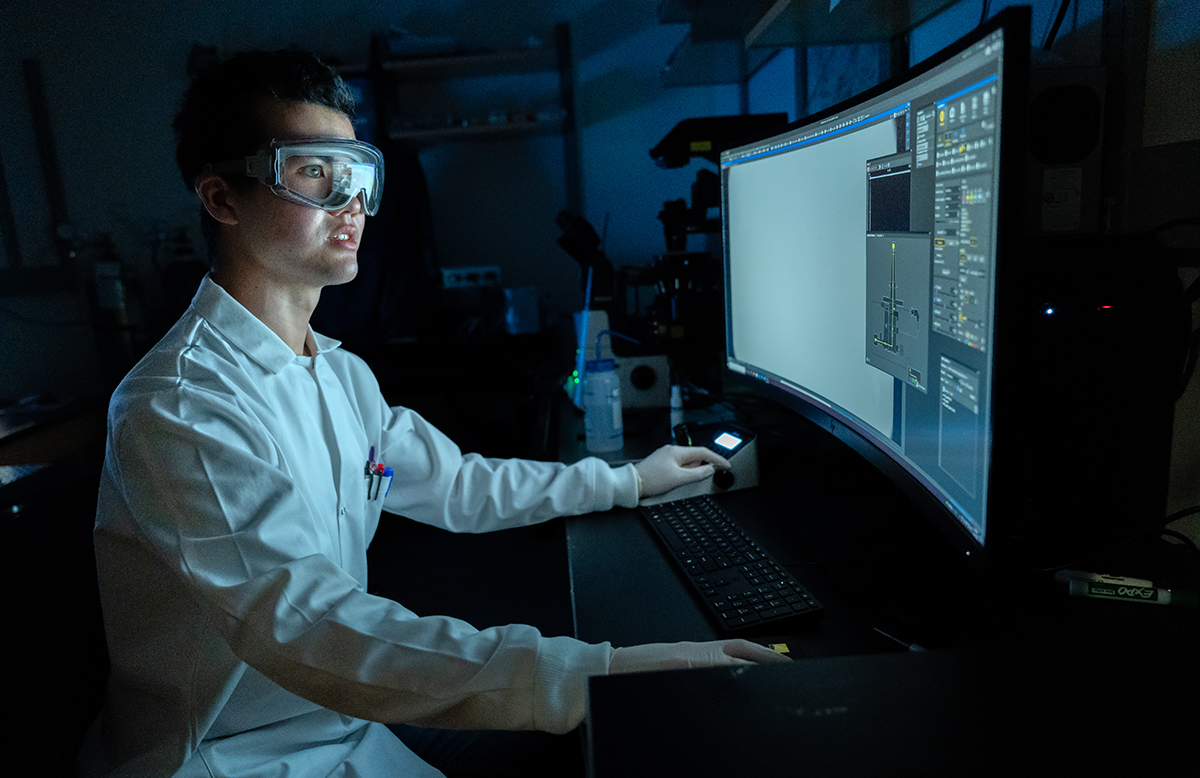Class Act
Waves of Curiosity
Creativity and an inquisitive nature lead biochemistry major and Goldwater Scholar Elliott Weix to a useful discovery.

In fall 2022, Elliott Weix BSx’27 started his senior year of high school with a new career goal: scientist. Weix had spent his summer in the lab of biochemistry professor Scott Coyle as part of the High School Science Research Internship Program (SRI), a partnership between UW–Madison and the Madison Metropolitan School District. There, his interests shifted from investigative journalism to investigating the natural world.
“I went beyond textbooks in Scott’s lab,” Weix recalls. “I wasn’t learning how a [cell signaling] pathway works or why my eyes aren’t the same color as my mom’s or dad’s. It was bigger than that: Look at all these possibilities that exist in life. Can we figure out how and why things work and use that knowledge as building blocks to make something else? That was exciting.”
When it came time to choose a college, staying close to family and continuing his research project made UW–Madison an easy choice. Now a junior majoring in biochemistry and math, Weix’s three years in Coyle’s lab have led him to exciting avenues of research.
“In addition to his scientific rigor and careful observation, Elliott is a creative thinker,” Coyle says. “That creativity allows him to see possibilities in the unknown.”
Curiosity led Weix, a 2025 Goldwater Scholar, to make a novel observation in the lab: unusual behavior in a system of proteins that may serve as a tool for studying cell development and differentiation. It’s something he’s exploring further this year.
In Coyle’s lab, scientists design networks of proteins that interact to induce a new function in a cell and to help scientists understand existing cellular processes. Of particular interest are proteins that interact in ways that cause molecules to move in wave-like patterns in bacteria. Researchers in his lab explore how these proteins behave when the same system is engineered into a yeast or mammalian cell. Weix was tasked with characterizing the ways that thousands of variations to this system impact the length and speed of the waves in yeast cells.
“I was observing variations under the microscope, and I saw a wave pattern that was unlike the rest,” Weix says. “I didn’t know exactly what I was seeing, but seeing something unexpected gives us a chance to ask new questions.”
The unique waves moved slowly — so slowly, in fact, that when the yeast cell divided, all the wave-inducing proteins were sequestered to one side, resulting in an asymmetrical division between the parent cell and its daughter.
Asymmetrical cell division lies at the crux of organismal development. Weix’s observation may be the first step toward creating a tool that researchers can use to mimic and study early stages of embryonic development and how different body parts take form.
But, Coyle emphasizes, there’s also inherent value in a young scientist like Weix simply exploring, without a specific goal in mind. “This is where Elliott’s creativity comes into play. By inducing asymmetry, he can ask questions about what happens to one cell relative to the other when molecules are distributed asymmetrically. It’s a great project for a student who just loves to learn new things.”
This article was posted in Basic Science, Class Act, Fall 2025 and tagged Biochemistry, Goldwater Scholarship Program, Scott Coyle.
